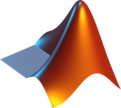
Back ماتلاب Arabic MATLAB Azerbaijani MATLAB Bulgarian ম্যাটল্যাব Bengali/Bangla MATLAB BS MATLAB Catalan ماتلاب CKB MATLAB Czech MATLAB Danish Matlab German
| Paradigm | multi-paradigm: functional, imperative, procedural, object-oriented, array |
|---|---|
| Designed by | Cleve Moler |
| Developer | MathWorks |
| First appeared | late 1970s |
| Stable release | |
| Typing discipline | dynamic, weak |
| Filename extensions | .m, .p,[1] .mex*,[2] .mat,[3] .fig,[4] .mlx,[5] .mlapp,[6] .mltbx,[7] .mlappinstall,[8] .mlpkginstall[9] |
| Website | mathworks.com |
| Major implementations | |
| MATLAB Software, GNU Octave, Sysquake | |
| Influenced by | |
| Influenced | |
| |
 L-shaped membrane logo[18] | |
| Developer(s) | MathWorks |
|---|---|
| Initial release | 1984 |
| Stable release | |
| Written in | C/C++, MATLAB |
| Operating system | Windows, macOS, and Linux[19][20] |
| Platform | IA-32, x86-64, ARM64 |
| Type | Numerical computing |
| License | Proprietary commercial software |
| Website | mathworks.com |
MATLAB (an abbreviation of "MATrix LABoratory"[21]) is a proprietary multi-paradigm programming language and numeric computing environment developed by MathWorks. MATLAB allows matrix manipulations, plotting of functions and data, implementation of algorithms, creation of user interfaces, and interfacing with programs written in other languages.
Although MATLAB is intended primarily for numeric computing, an optional toolbox uses the MuPAD symbolic engine allowing access to symbolic computing abilities. An additional package, Simulink, adds graphical multi-domain simulation and model-based design for dynamic and embedded systems.
As of 2020[update], MATLAB has more than four million users worldwide.[22] They come from various backgrounds of engineering, science, and economics. As of 2017[update], more than 5000 global colleges and universities use MATLAB to support instruction and research.[23]
- ^ "Protect Your Source Code". MathWorks. Retrieved November 1, 2019.
- ^ "MEX Platform Compatibility". MathWorks. Retrieved November 1, 2019.
- ^ "MAT-File Versions". MathWorks. Retrieved November 1, 2019.
- ^ "Save Figure to Reopen in MATLAB Later". MathWorks. Retrieved November 1, 2019.
- ^ "Live Code File Format (.mlx)". MathWorks. Retrieved November 1, 2019.
- ^ "MATLAB App Designer". MathWorks. Retrieved November 1, 2019.
- ^ "Toolbox Distribution". MathWorks. Retrieved November 1, 2019.
- ^ "MATLAB App Installer File". MathWorks. Retrieved November 1, 2019.
- ^ "Support Package Installation". MathWorks. Retrieved November 1, 2019.
- ^ "An interview with CLEVE MOLER Conducted by Thomas Haigh On 8 and 9 March, 2004 Santa Barbara, California" (PDF). Computer History Museum. Archived from the original (PDF) on December 27, 2014. Retrieved December 6, 2016.
So APL, Speakeasy, LINPACK, EISPACK, and PL0 were the predecessors to MATLAB.
- ^ Bezanson, Jeff; Karpinski, Stefan; Shah, Viral; Edelman, Alan (February 14, 2012). "Why We Created Julia". Julia Language. Retrieved December 1, 2016.
- ^ Eaton, John W. (May 21, 2001). "Octave: Past, Present, and Future" (PDF). Texas-Wisconsin Modeling and Control Consortium. Archived from the original (PDF) on August 9, 2017. Retrieved December 1, 2016.
- ^ "History". Scilab. Archived from the original on December 1, 2016. Retrieved December 1, 2016.
- ^ S.M. Rump: INTLAB – INTerval LABoratory. In Tibor Csendes, editor, Developments in Reliable Computing, pages 77–104. Kluwer Academic Publishers, Dordrecht, 1999.
- ^ Moore, R. E., Kearfott, R. B., & Cloud, M. J. (2009). Introduction to Interval Analysis. Society for Industrial and Applied Mathematics.
- ^ Rump, S. M. (2010). Verification methods: Rigorous results using floating-point arithmetic. Acta Numerica, 19, 287–449.
- ^ Hargreaves, G. I. (2002). Interval analysis in MATLAB. Numerical Algorithms, (2009.1).
- ^ "The L-Shaped Membrane". MathWorks. 2003. Retrieved February 7, 2014.
- ^ "System Requirements and Platform Availability". MathWorks. Retrieved August 14, 2013.
- ^ "Platform Road Map for MATLAB and Simulink Product Families". de.mathworks.com. Retrieved December 22, 2021.
- ^ "Matrices and Arrays - MATLAB & Simulink". www.mathworks.com. Retrieved May 21, 2022.
- ^ The MathWorks (February 2020). "Company Overview" (PDF).
- ^ "Current number of matlab users worldwide". Mathworks. November 9, 2017. Retrieved April 26, 2023.